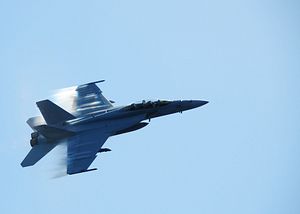Late last week, reports emerged that the Indian Navy had formally stated its interest in a new carrier-based multirole combat aircraft. According to IHS Jane’s Navy International, the Indian Navy formally issued a request for information (RFI) for a carrier-based fighter after “the Hindustan Aeronautics Limited (HAL) Tejas Light Combat Aircraft (LCA) was rejected as being unsuitable for service.”
After decades of delays and setbacks, the LCA never quite got over a major problem that limited its utility for Indian carrier aviation requirements. Simply put, among other issues, the LCA was unable to take off from a carrier top reliably with a full weapons load, significantly limiting its capability to serve as a potent core of the Indian Navy’s existing and future carrier airwings.
The LCA was thus canceled in December 2016, after comments hinting at its fate by Admiral Sunil Lamba, India’s chief of naval staff. Formally, the reason given was that the LCA did not meet the “operational capability” the Indian Navy required. (Abhijit Singh took a more detailed look at the factors leading up to the cancellation in The Diplomat.)
The RFI that was mooted last week specifically attempts to address this “operational capability” shortcoming. According to Jane’s, the Indian Navy is looking for 57 Multi-Role Carrier Borne Fighters for its INS Vikramaditya and INS Vikrant carriers. Specifically, the requirement is for a fighter that meets the following conditions: “capable of operations during day and night, and in all weather conditions; and be suitable for shipborne air defense, air-to-surface, ‘buddy-buddy’ aerial refuelling, reconnaissance, electronic warfare, and other unspecified roles.”
The Indian Navy has also inquired about potential candidate fighters’ suitability for both Short Take-off But Arrested Recovery (STOBAR) and Catapult Take-off But Arrested Recovery (CATOBAR) carrier operations. The Indian Navy currently only operates STOBAR-equipped ski-jump deck carriers, but one of the ongoing topics of defense technological collaboration with the United States includes discussion for the possible transfer of the Electromagnetic Aircraft Launch System (EMALS), which would entail the adoption of CATOBAR on future carriers. India’s second indigenously built Vikrant-class carrier, the INS Vishal, would be the first to incorporate EMALS, if the transfer was finalized.
For longtime watchers of Indian military aviation procurement, the introduction of a new ambitious tender process may raise concerns. If the RFI progresses to a competitive Request for Proposal (RFP) process and a final vendor is chosen, negotiations between the chosen provider and the Indian government may run into problems over indigenization, offsets, and technology transfer.
It was precisely these concerns that lead to the scrapping of the Medium Multi-Role Combat Aircraft (MMRCA) tender that had once been referred to as the “Mother of all Defense Deals.” Similarly, France and India were bogged down in delays over these topics after Indian Prime Minister Narendra Modi and French President Francois Hollande agreed to a deal for New Delhi to purchase 36 Dassault Rafale fighters in fly-away condition in March 2015.
U.S. manufacturers like Boeing may see an edge for themselves given last year’s elevation of India to the status of the “Major Defense Partner” in the eyes of the U.S. government. The designation is expected to “facilitat[e] technology sharing with India to a level commensurate with that of its [the United States’] closest allies and partners,” the White House noted last year.
In particular, Boeing’s F/A-18 Super Hornet may emerge as a strong contender. As I discussed last year, the Indian government entered exploratory talks with Boeing’s chief executive officer in February. Other contenders that may fit the bill include the Dassault Rafale — which would be technically attractive given logistical and maintenance synergies with New Delhi’s awaited delivery of 36 jets to the Indian Air Force — the Russian MiG-29K, and Sweden’s Saab Gripen. The Gripen, notably, would be a single-engine jet, like the HAL Tejas.

































